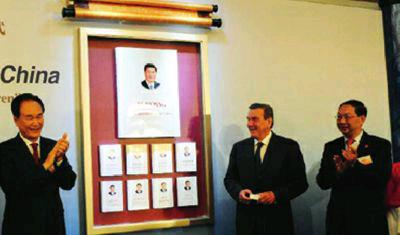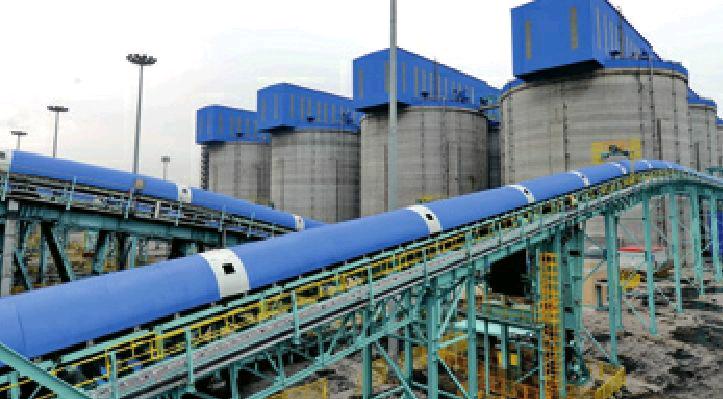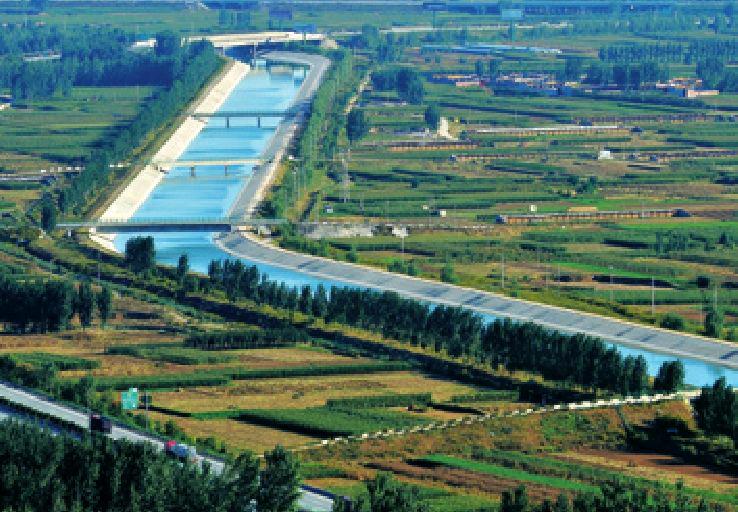Xi’s Speeches Chronicled
2014-10-29
A book containing Chinese President Xi Jinpings remarks on governance makes its debut on October 8 at the Frankfurt Book Fair in Germany.Cai Mingzhao (left), Minister of the Information Office of Chinas State Council, Gerhard Schroeder (center), former German Chancellor, and Shi Mingde, Chinese Ambassador to Germany, attended the launch ceremony.
The book, containing 18 chapters by Xi from November 15, 2012 to June 13, 2014, is available in a multitude of languages including Chinese, English, French, Russian, Arabic, Spanish, Portuguese, German and Japanese.
Most Polluted Province
Hebei, north Chinas worst-polluted province, set a string of ecological restoration goals for rivers, lakes, mines, forests and groundwater.
The province, which surrounds Beijing and Tianjin, will plant 530,000 hectares of forest by 2017 and raise forest coverage from 28 percent in 2013 to 32 percent, according to a recently unveiled plan.
By 2017, no rivers or tributaries should have water quality below Grade V, said the document. China grades water quality according to six levels: grades I to V and “inferior to Grade V.” Water below Grade III is unsafe to drink.
Hebei will address 664 open-pit mines close to railways, highways or towns within two years. In 2014, 10 illegal mines, 46 licensed mines and 32 mining firms are to be shut down. Another 251 mines that have failed to meet environ- mental protection requirements will halt production for restoration. By 2015, ecological restoration will be completed for 325 more mines.
Total investment in the projects will be more than 60 billion yuan($9.7 billion).
Hebei is under heavy pressure to cut emissions and treat pollution. It had seven of the 10 most polluted cities in China as of the first half of this year, according to the Ministry of Environmental Protection.
Better Urban Living
The Central Government hopes to offer more quality jobs to migrant workers to help ease them into urban living.
To do so, the State Council plans to provide professional training to 20 million surplus rural labor workers per year until 2020. The goal is to boost work conditions, ensure pay schedules and make sure they are covered by social security, a policy guideline published by the State Council stated on September 30.
Official data showed that, at the end of June, China had 174 million migrant workers, defined as those who come from rural areas and work low-skilled jobs not requiring profession qualification somewhere in a city.
According to the guideline, migrant workers will enjoy the same treatment as urban residents in terms of social security.
By 2020, migrant workers and families will also enjoy equal access to basic public services in cities, including education, community hospitals and public housing.
Military Info Security
Chinas central military authority has issued guidelines to enhance management of military information and crack down on illegal online activities involving military affairs, a military newspaper said on October 8.
The circular was issued by the Central Military Commission (CMC) to strengthen military information security of the Chinese Peoples Liberation Army(PLA) and armed police, according to the PLA Daily.
Efforts should be made to promote domestically developed information infrastructure, including Chinese-produced software, to innovate and improve information security defense, and to offer personnel support for information management, the circular said.
Comprehensive management and control measures should be carried out to ensure security of important personnel, core data and key devices, the guidelines said.
Calling increased information security “a bottom-line project” for improving combat readiness, the document said pragmatic measures should be adopted to solve conflicts and other pressing issues.
Repairing the Ecosystem
Over 7 million rare fish have been released into the upper reaches of the Yellow River, Chinas second largest, since 2009 to help to repair its ecosystem, according to local fishery authorities.
Qinghai Province in the northwest, where the Yellow River and Yangtze River originate, plans to release around 900,000 rare, captive-bred, native fish this year in order to replenish stocks, Wang Guojie, Deputy Chief of the provinces fishery environment supervision office, revealed.
The Ministry of Agriculture, which is also in charge of fishery affairs, announced in 2007 that one third of the 150 fish species in the Yellow River were believed to be extinct due to human encroachment and low rainfall.
Over fishing, dumping and hydropower projects degraded the environment and led to a shrinking fish population. In Qinghai, there are 22 fish species native to the rivers there, with many of them being found only on the Qinghai-Tibet plateau.
Qinghai has plans to build more fish farms and expand the projects release area.
New Marine Satellites
China will launch a new “constellation” of marine surveillance satellites in 2019 to monitor ships, oil rigs, marine disasters and land-based resources.
According to Lin Mingsen, Deputy Director of the National Satellite Ocean Application Service, the HY-3 cluster will include a series of satellites that employ synthetic aperture radar technology, “capable of operating day or night... and in all weather conditions.” The satellites will be able to see meter-long objects from space and generate highdefinition imagery of both land and ocean surfaces, Lin said.
He said the satellites would be used to monitor ships and drilling platforms, in addition to marine oil spills, sea ice, ocean waves and surface winds among other features.
Red Moon
Combined photo taken on October 8 shows the process of a total lunar eclipse in Nanjing, capital of east Chinas Jiangsu Province.
A total lunar eclipse is sometimes called a blood moon because of the red color that is cast upon it by light refracting in Earths atmosphere.
The phenomenon was seen world wide on October 8.
Glorious Corps
Chinese Vice Premier Liu Yandong urges the Xinjiang Production and Construction Corps (XPCC) to act as a stabilizer in the countrys northwestern autonomous region.
Liu made the remarks when addressing the ceremony for the 60th founding anniversary of the XPCC on October 7.
Starting from scratch, the XPCC has reclaimed ecological oases from the desolate Gobi desert, initiated Xinjiangs modernization, built large-scale agriculture and industrial and mining enterprises, and established new cities and towns in cooperation with local people of different ethnic groups.
Altered Forecast
The World Bank said on October 6 in Singapore that it has cut the growth target forecasts for China to 7.4 percent in 2014 and 7.2 percent in 2015, as China pushes forward structural reforms to address financial vulnerabilities and structural constraints.
“Measures to contain local government debt, curb shadow banking, and tackle excess capacity, high energy demand and high pollution will reduce investment and manufacturing output,”said a representative for the bank, regarding Chinas outlook.
However, Sudhir Shetty, the World Banks Chief Economist in East Asia and the Pacific Region, claimed that Chinas slowdown in economy will be gradual and this does not represent the bottom falling out of Chinas growth. She added that the downward trend in China will not have a dramatic impact on other countries.
The World Bank proposed that Chinas structural reforms in sectors such as state-owned enterprises and services could help “offset the impact of measures to contain local government debt and curb shadow banking.”
As to the property market, the bank said that “a major nationwide correction in real estate prices in China remains unlikely, although there may be pressure on prices in several of the less rapidly growing provinces.”
Loosening Credit
Second home buyers in China will face lower down payments due to relaxed restrictions.
Chinese citizens who wish to buy a second home will enjoy the same 30-percent down payment required of first-time home buyers if they have fully repaid their mortgage loans, the Peoples Bank of China (PBC), the central bank, and the China Banking Regulatory Commission (CBRC) said in a joint announcement on September 30.
Prior to the announcement, second home buyers were required to set down at least a 60-percent down payment.
The move marked a turning point in the nations restrictive home purchasing policies.
In 2011, skyrocketing home prices forced the government to roll out restrictive measures, such as requiring higher down payments and increasing the lending rate for second home purchases, as well as banning the purchase of a third home.
According to the latest announcement, first home buyers will have access to a maximum 30-percent discount on home loan rates offered by banks, while the minimum down payment remains at 30 percent. The PBC and the CBRC also said that they will require their regional branches to outline supportive home loan measures based on local government requirements.
A Fresh Approach
Closed coal transmission lines are in full swing at a port in Huanghua City, north Chinas Hebei Province, on October 6. The port is an important transport hub for shipping coal from north China. But loading and transporting coal used to cause severe pollution in the city. Since 2010, the port has invested heavily on the construction of facilities that can greatly reduce pollution.
Unified Trading
Investors on the Chinese mainland can now trade securities through a single account at different brokerages and stock exchanges as the unified account platform—a mechanism designed to integrate different trading systems in the securities markets—was officially initiated on October 8.
As a result, investors can switch among different brokerages without opening new accounts and closing their existing ones. They can also use the platform to operate multiple subaccounts for different types of securities and investment purposes, according to the China Securities Depository and Clearing Corp. Ltd., a state-owned clearing service company.
Previously, individual investors had to pay separate account fees if they wanted to trade in Shanghai and Shenzhen stock exchanges. Under the new rule, they are only required to pay a one-time fee of 40 yuan ($6.5) in order to trade in the markets.
Analysts said that the reform is likely to attract fresh capital to the stock markets.
Private Banks
The China Banking Regulatory Commission (CBRC), the countrys banking regulator, said on September 29 that it had approved another two private banks, with one in Shanghai and the other in Zhejiang Province. The CBRC requires the banks to be established within six months from September 29.
A 30-percent stake of the Zhejiangbased bank will be funded by a microbusiness financing company indirectly controlled by New York-listed Alibaba Group, Chinas largest e-commerce business. The Shanghai-based conglomerate Fosun Group will contribute 25 percent of funding, and Chinas largest auto parts supplier, Wanxiang Group, will hold an 18-percent stake in the new private bank.
The new Shanghai-based private bank will receive 30 percent of its funding from Juneyao Group, another Shanghai-based conglomerate, and 15 percent of its funding will come from Metersbonwe Group, a leading casual wear apparel company in China.
On July 25, the CBRC already approved the establishment of three private banks. Currently, China has only one private bank in service, China Minsheng Bank, which was founded in Beijing in 1996.
PMI Data
The manufacturing purchasing managers index (PMI), a key measure of factory activity, posted at 51.1 in China in September, unchanged from Augusts reading, according to data released by the National Bureau of Statistics (NBS) and the China Federation of Logistics and Purchasing (CFLP).
A reading above 50 indicates expansion, while a reading below 50 represents contraction. The NBS manufacturing PMI samples 3,000 enterprises of various sizes nationwide.
Among the sub-indices of the PMI, the production sub-index posted at 53.6, up 0.4 percentage points from August, and was the second highest reading this year, coming in just behind to the 54.2 reading in July.
“The September PMI remained above the 50 threshold, which indicated no change to the basic trend of steady economic growth in the future,” said Zhang Liqun, an economist at the Development Research Center of the State Council.
The rise of the production subindex suggested a rebound of industrial growth last month, he added.
In September, the PMI of nonmanufacturing sectors stood at 54 percent, down 0.4 percentage points from the previous month, according to the NBS and the CFLP.
Cai Jin, deputy head of the CFLP, said that the data showed Chinas overall non-manufacturing business activity grew steadily in September. Satisfactory performance in the construction sector and overall optimism suggested that investment support stable growth in the near term, he noted.
Budget Management
The State Council, Chinas cabinet, on October 8 unveiled an action plan for better budget management as part of efforts to build a more transparent and efficient fiscal and taxation system.
The long-awaited decision was seen as the first step in jump-starting a new round of broader fiscal and taxation reforms by 2020, as it tries to ensure all government revenue and spending is covered by the management system.
In the document, the State Council outlines seven reform tasks for the budgets drafting, implementation, transparency and supervision, ordering a clear division of roles between the government and the market.
A multi-year budget-balancing scheme will be introduced to better manage and control unused government expenditures in the fiscal year, while local government debt will be regulated more strictly to guard against fiscal risks, according to the plan.
Fiscal preferential measures need to be gradually withdrawn in sectors and areas where market forces can play their role, it said, adding that government expenditures outside the budget will be supervised in order to prevent corruption.
Diversionary Tactics
Pictured is the Baoding section of the central line of the South-to-North Water Diversion Project on October 5. The first stage of the central line has been completed and will be put into use after the flood season this year.
